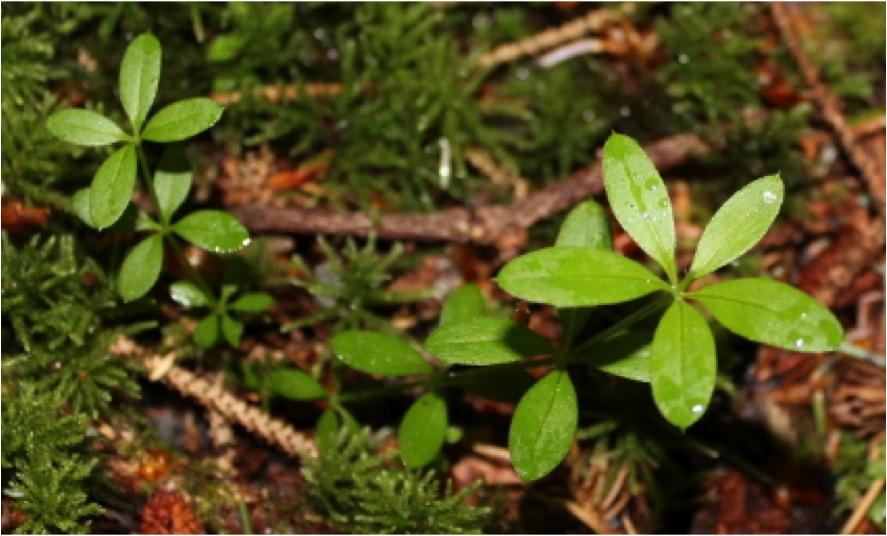Sweet-scented bedstraw • Galium triflorum
Identification
This perennial plant has weak, often creeping or climbing stems that reach 80 cm long. Its leaves form whorls at intervals along the stem. Each whorl has 4-6 unstalked leaves measuring 1.5-4.5 cm long. Leaves are elongated, with hairy edges and a single vein bearing hooked bristles on the underside of the leaf. The tiny white flowers appear in loose clusters of 3 (usually), on stalks from leaf axils or at the end of the stem. This species releases a sweet vanilla-like scent when bruised or while drying.
Habitat & Range
Sweet-scented bedstraw is a common species in BC, and is found in wet forest and along stream banks from lowland to montane elevations. It prefers shady locations and nitrogen-rich soils. It is a circumpolar species, found throughout much of North American and Eurasia.
Similar Species
Cleavers (G. aparine) is a similar species; unlike cleavers, sweet-scented bedstraw has a sweet scent, rhizomatous stems, and smooth (not ‘sticky’) stalk. The leaves of cleavers tend to be narrower and with 6-8 per whorl. Additionally, the bristles along the leave margins of cleavers point backward (towards the stem), while those of sweet-scented bedstraw point forward.
Human Uses
Sweet-scented bedstraw was used by some Ditidaht for a hair conditioner and the flowers were dried for perfume.
This perennial plant has weak, often creeping or climbing stems that reach 80 cm long. Its leaves form whorls at intervals along the stem. Each whorl has 4-6 unstalked leaves measuring 1.5-4.5 cm long. Leaves are elongated, with hairy edges and a single vein bearing hooked bristles on the underside of the leaf. The tiny white flowers appear in loose clusters of 3 (usually), on stalks from leaf axils or at the end of the stem. This species releases a sweet vanilla-like scent when bruised or while drying.
Habitat & Range
Sweet-scented bedstraw is a common species in BC, and is found in wet forest and along stream banks from lowland to montane elevations. It prefers shady locations and nitrogen-rich soils. It is a circumpolar species, found throughout much of North American and Eurasia.
Similar Species
Cleavers (G. aparine) is a similar species; unlike cleavers, sweet-scented bedstraw has a sweet scent, rhizomatous stems, and smooth (not ‘sticky’) stalk. The leaves of cleavers tend to be narrower and with 6-8 per whorl. Additionally, the bristles along the leave margins of cleavers point backward (towards the stem), while those of sweet-scented bedstraw point forward.
Human Uses
Sweet-scented bedstraw was used by some Ditidaht for a hair conditioner and the flowers were dried for perfume.
References
Galium triflorum Michx. In Klinkenberg, Brian. (Ed.). E-Flora BC: Electronic Atlas of the Plants of British Columbia. Lab for Advanced Spatial Analysis, Department of Geography, University of British Columbia, Vancouver. Accessed 10/04/2014.
Pojar, J. and MacKinnon, A. (1994). Plants of Coastal British Columbia. Vancouver, BC: Lone Pine Publishing. P. 330.
Authors and editors of page
Kelly Fretwell, Andrew Sheriff, and Brian Starzomski (2014).
Galium triflorum Michx. In Klinkenberg, Brian. (Ed.). E-Flora BC: Electronic Atlas of the Plants of British Columbia. Lab for Advanced Spatial Analysis, Department of Geography, University of British Columbia, Vancouver. Accessed 10/04/2014.
Pojar, J. and MacKinnon, A. (1994). Plants of Coastal British Columbia. Vancouver, BC: Lone Pine Publishing. P. 330.
Authors and editors of page
Kelly Fretwell, Andrew Sheriff, and Brian Starzomski (2014).




